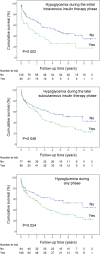Hypoglycemia during hyperosmolar hyperglycemic crises is associated with long-term mortality
- PMID: 38594758
- PMCID: PMC11005231
- DOI: 10.1186/s13098-024-01329-5
Hypoglycemia during hyperosmolar hyperglycemic crises is associated with long-term mortality
Abstract
Background: Previous research has indicated that hypoglycemia during hospitalization is a predictor of unfavorable outcomes in patients with diabetes. However, no studies have examined the long-term impact of hypoglycemia in adults admitted for hyperglycemic crises. The study was aimed to investigate the long-term implications of hypoglycemia during hyperosmolar hyperglycemic crises, particularly in terms of all-cause mortality.
Methods: This retrospective cohort study included 170 patients (82 men [48.2%], median age 72 years) admitted to a university hospital for hyperosmolar hyperglycemic crises, including pure hyperosmolar hyperglycemic states and hyperosmolar diabetic ketoacidoses. We separately investigated the prognostic significance of hypoglycemia on mortality during the initial intravenous insulin therapy phase and during the later subcutaneous insulin therapy phase, both during hospitalization and in the long term (median follow-up, 652 days; range 2-3460 days).
Results: Both hypoglycemia during the initial intravenous insulin therapy phase (observed in 26.5% of patients) and hypoglycemia during the later subcutaneous insulin therapy phase (observed in 52.7% of patients) were associated with long-term mortality. After adjusting for potential confounders, hypoglycemia during the initial intravenous insulin therapy phase remained associated with mortality (hazard ratio 2.10, 95% CI 1.27-3.46, p = 0.004).
Conclusions: Hypoglycemia during hyperosmolar hyperglycemic crises is a marker of long-term mortality, especially when it occurs during the initial intravenous insulin therapy phase.
Keywords: Diabetic ketoacidosis; Hyperosmolar hyperglycemic state; Hypoglycemia; Mortality.
© 2024. The Author(s).
Conflict of interest statement
The authors declare no competing interests for the present study.
Figures
Similar articles
-
Clinical Outcomes in Patients With Isolated or Combined Diabetic Ketoacidosis and Hyperosmolar Hyperglycemic State: A Retrospective, Hospital-Based Cohort Study.Diabetes Care. 2020 Feb;43(2):349-357. doi: 10.2337/dc19-1168. Epub 2019 Nov 8. Diabetes Care. 2020. PMID: 31704689 Free PMC article.
-
Risk Factors for Hypoglycemia During Treatment of Hyperglycemic Crises.Diabetes Spectr. 2022 Fall;35(4):484-490. doi: 10.2337/ds21-0094. Epub 2022 Jun 13. Diabetes Spectr. 2022. PMID: 36561649 Free PMC article.
-
Moderate-Intensity Insulin Therapy Is Associated With Reduced Length of Stay in Critically Ill Patients With Diabetic Ketoacidosis and Hyperosmolar Hyperglycemic State.Crit Care Med. 2019 May;47(5):700-705. doi: 10.1097/CCM.0000000000003709. Crit Care Med. 2019. PMID: 30855284
-
Thirty years of personal experience in hyperglycemic crises: diabetic ketoacidosis and hyperglycemic hyperosmolar state.J Clin Endocrinol Metab. 2008 May;93(5):1541-52. doi: 10.1210/jc.2007-2577. Epub 2008 Feb 12. J Clin Endocrinol Metab. 2008. PMID: 18270259 Free PMC article. Review.
-
Management of Hyperglycemic Crises: Diabetic Ketoacidosis and Hyperglycemic Hyperosmolar State.Med Clin North Am. 2017 May;101(3):587-606. doi: 10.1016/j.mcna.2016.12.011. Med Clin North Am. 2017. PMID: 28372715 Free PMC article. Review.
Cited by
-
Post-hypoglycemic nocturnal hyperglycemia in type 1 diabetes: the Somogyi hypothesis revisited.Hormones (Athens). 2025 Jun 4. doi: 10.1007/s42000-025-00680-0. Online ahead of print. Hormones (Athens). 2025. PMID: 40465171
-
Successful Management of Extreme Hyperglycemia (134 mmol/L) Secondary to Chronic Pancreatitis Causing Critical Hyperosmolar Coma: A Case Report.Case Rep Endocrinol. 2025 Jun 3;2025:4737440. doi: 10.1155/crie/4737440. eCollection 2025. Case Rep Endocrinol. 2025. PMID: 40496635 Free PMC article.
References
-
- Umpierrez GE, Murphy MB, Kitabchi AE. Diabetic ketoacidosis and hyperglycemic hyperosmolar syndrome. Diabetes Spectr. 2002;15:28–36. doi: 10.2337/diaspect.15.1.28. - DOI
LinkOut - more resources
Full Text Sources


